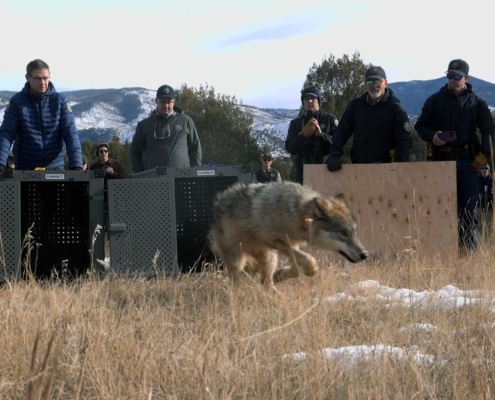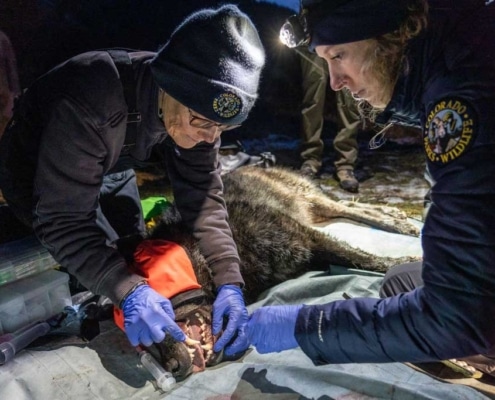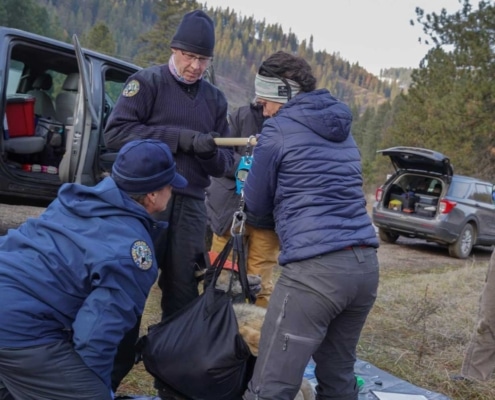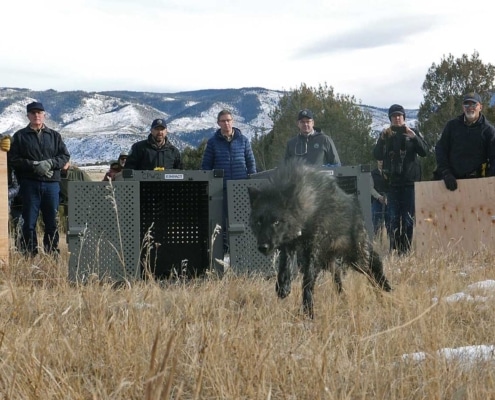
Colorado Parks and Wildlife released five gray wolves onto public land in Grand County, Colorado on Monday, December 18, 2023. Pictured is wolf 2303-OR.
On Dec. 18, 2023, Colorado Parks and Wildlife (CPW), as part of the state’s wolf reintroduction plan, released the first five wolves on state-owned land in Grand County, Colorado. Throughout that week, CPW released five more wolves in Grand and Summit Counties, with the last wolf released Dec. 22. The release of these 10 wolves—six females and four males—marked an important phase in restoring the wolf to a state in which it had been extirpated during the 1940s.
In November 2020, voters in Colorado passed by a narrow margin Proposition 114, an initiative that called for the reintroduction of wolves to the Western Slope. Both this proposition and Colorado’s wolf restoration plan required the introduction of wolves to begin by the end of 2023.
The news is generally positive as CPW works to protect the wolves while also helping farmers and ranchers learn to co-exist with them.
The wolves
CPW, through an agreement with Oregon, obtained nine wolves from several packs located in northwestern Oregon. Another wolf, a female, was traveling on her own when she was caught.

Colorado Parks and Wildlife veterinarian Pauline Nol and biologist Ellen Brandell examine 2307-OR on Dec. 17, 2023.
Prior to releasing the wolves, CPW outfitted each with a GPS radio collar identifying the wolf by its release year, sex and state of origin.
To date, two wolves’ collars have failed. In another instance, a female wolf’s collar stopped and then started again. It also showed her to be staying in one area. Wildlife officers said this data suggests that she is preparing a den for pups. On April 18 the collar of a yearling male showed that he had died. A necropsy determined that the wolf was most likely killed by a mountain lion.
Points of conflict: Lawsuits, livestock and lethal management
In the week prior to the wolf release, two lawsuits were filed in Federal Court. On Dec. 11, 2023, the livestock producers’ association accused CPW and the U.S. Fish and Wildlife Service (USFWS) of failing to perform the required environmental impact studies on wolf reintroduction. Expressing concerns that wolves posed a threat to their livestock and livelihood, they also requested an immediate temporary restraining order to halt the release. Federal judge Regina Rodriguez denied their request to stay the release of wolves, stating that a delay would go against voters’ approval of Proposition 114.

Colorado Parks and Wildlife staff weighs wolf 2304-OR on Dec. 17, 2023.
On Dec. 14, the Colorado Conservation Alliance (CCA) filed a lawsuit bringing similar charges against the USFWS and CPW while expressing concerns about the impact of the reintroduced gray wolves in Colorado on the endangered Mexican gray wolf’s recovery in New Mexico and Arizona. Both lawsuits are ongoing.
On April 2, 2024, a livestock producer in Grand County reported a calf killed in a suspected wolf attack. Wildlife officers confirmed that the wounds were consistent with those caused by a wolf. Since then, nine more wolf depredation incidents have been confirmed: one in Routt County, three in Jackson County and five in Grand County. Two male wolves have been implicated in five repeat attacks on one farm in Grand County.
Farmers and ranchers are demanding that CPW and the state lethally remove the two wolves involved in these repeated attacks. Fueling their fears and anger are reports that these two individuals are from the Five Points Pack, known for its chronic depredation of livestock in Oregon.
CPW director Jeff Davis denied that any of the translocated wolves were involved in chronic depredations, stating that Oregon Department of Fish and Wildlife had lethally removed wolves suspected of chronic depredation in the months prior to the capture and translocation of wolves to Colorado.
However, the term “chronic depredation” has become a point of contention. In November 2023, USFWS designated gray wolves in Colorado a “non-essential experimental” population under section 10j of the Endangered Species Act. Species are listed as experimental if they are to be released into natural habitat outside their current range. The designation also gives state wildlife officers flexibility in managing problem animals, including killing wolves involved in “chronic depredation” of livestock.
Still, according to Eric Odell, CPW wolf conservation program manager, creators of Colorado’s wolf plan intentionally left its definition vague, choosing not to specify how many repeat attacks constituted “chronic depredation” and would allow for the lethal removal of specific wolves. Instead, the plan’s writers chose to wait and “learn what it is like to live with wolves in Colorado…”
For CPW, the lethal removal of wolves is presently not an option for other reasons as well. One of the two male wolves involved in the repeated depredation incidents is the mate of the female wolf who gave birth to at least one pup. Killing the male potentially leaves the offspring more vulnerable, with less adult care. Davis also stated that killing the wolves would be “irresponsible management” as the number of wolves is well below the state’s restoration goals.
Instead, CPW and the state have responded to ranchers’ and farmers’ concerns by providing them with nonlethal measures to prevent wolf attacks, such as flags, fencing and range riders. They have also established a fund to compensate livestock producers up to $15,000 for each animal lost to wolf depredation.
To keep livestock producers and the public informed about the wolves, CPW has developed two web tools. One site provides an up-to-date list of confirmed depredations, including the date, number of livestock injured or killed and the county where it occurred. Another site uses data collected from the GPS collars to create a map showing the watersheds that wolves used over the past month.

Colorado Parks and Wildlife released five gray wolves onto public land in Grand County, Colorado on Monday, December 18, 2023. Pictured is wolf 2302-OR.
Going ahead
While CPW continues to monitor the reintroduced wolves, the agency is preparing for the next phase of reintroduction. The wolf restoration plan requires the release of 10 to 15 wolves for each of three to five years with a total of 50 wolves to be reintroduced. The next wolf release is scheduled for winter 2024-2025. CPW has made an agreement with the Confederated Tribes of Colville Reservation in Oregon to capture and relocate up to 15 wolves. In an email, Odell noted: “After that, we will continue our monitoring efforts and, if necessary, we’ll supplement the population, or if it appears to be doing well, we will pause the active reintroduction.”
 This article is published in the Fall 2024 edition of International Wolf magazine, which is published quarterly by the International Wolf Center and mailed exclusively to its members.
This article is published in the Fall 2024 edition of International Wolf magazine, which is published quarterly by the International Wolf Center and mailed exclusively to its members.
To learn more about membership, click here.
About the author: Debra Mitts-Smith researches and writes about the wolf in literature and art. Her book, Picturing the Wolf in Children’s Literature, was published by Routledge in 2010. She is currently working on a cultural history of the wolf.

The International Wolf Center uses science-based education to teach and inspire the world about wolves, their ecology, and the wolf-human relationship.
